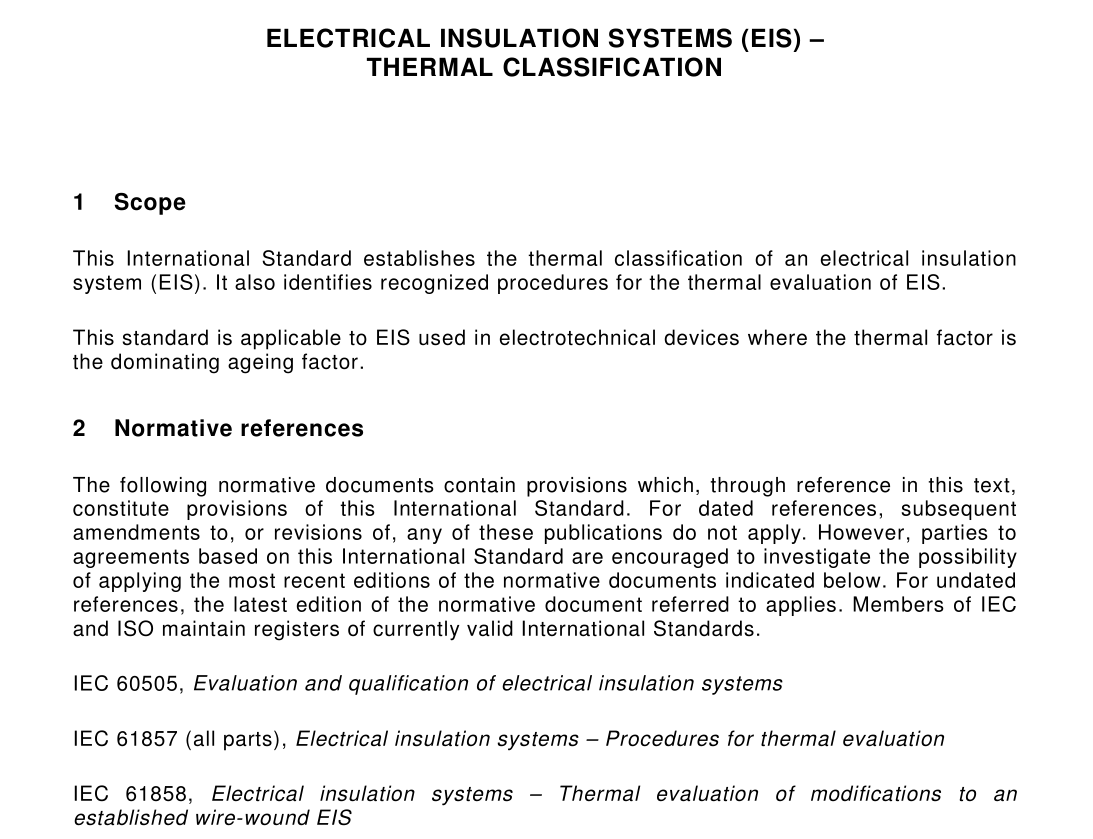IEC 62114 pdf download

IEC 62114 pdf download.Electrical insulation systems (EIS) – Thermal classification
1 Scope
This International Standard establishes the thermal classification of an electrical insulation system (EIS). It also identifies recognized procedures for the thermal evaluation of EIS. This standard is applicable to EIS used in electrotechnical devices where the thermal factor is the dominating ageing factor.
2 Normative references
The following normative documents contain provisions which, through reference in this text, constitute provisions of this International Standard. For dated references, subsequent amendments to, or revisions of, any of these publications do not apply. However, parties to agreements based on this International Standard are encouraged to investigate the possibility of applying the most recent editions of the normative documents indicated below. For undated references, the latest edition of the normative document referred to applies. Members of IEC and ISO maintain registers of currently valid International Standards. IEC 60505, Evaluation and qualification of electrical insulation systems IEC 61857 (all parts), Electrical insulation systems – Procedures for thermal evaluation IEC 61858, Electrical insulation systems – Thermal evaluation of modifications to an established wire-wound EIS
3 Definitions
For the purpose of this International Standard, the terms and definitions given in IEC 60505, as well as the following definition, apply: 3.1 thermal class designation of an EIS that is equal to the numerical value of the maximum use temperature in degrees Celsius (°C) for which the EIS is appropriate
4 General considerations
4.1 Thermal evaluation of EIS Experience has demonstrated that, under normal operating conditions, satisfactory economic life is obtained for electrotechnical devices such as rotating machines, transformers, etc., that are designed and built in accordance with standards based on thermal evaluations of EIS.4.2 Maximum use temperature The thermal classes in this standard are numerically equal to the maximum use temperatures recommended for the EIS under normal operating conditions as defined by the product technical committee. Product TCs shall determine the operating conditions under which the maximum temperature of the device may differ from the thermal class of the EIS. Such situations may occur because either a shorter or longer life than normal is envisaged, or exceptional conditions of service exist. 4.3 Relation of EIM to EIS The description of an electrotechnical device as being of a particular thermal class does not mean, and must not be taken to imply that each EIM used in its construction is of the same thermal endurance. The thermal class for an EIS may not be directly related to the thermal endurance of the individual EIM included in it. In the EIS, the protective character of other EIM used in the system may improve the thermal endurance of an individual EIM. On the other hand, problems of incompatibility between EIM may decrease the appropriate thermal class of the system below the thermal endurance of the EIM. Such situations shall be investigated by the test procedures referenced in clause 5. NOTE Thermal endurance of EIM is addressed in IEC 60216.4.4 Other factors of influence Apart from thermal factors, the ability of the EIS to fulfil its function is affected by many factors, such as electrical and mechanical stresses, vibration, deleterious atmospheres and chemicals, moisture, dirt and radiation. All such factors should be taken into account when designing particular electrotechnical devices, and further guidance on the evaluation of these aspects may be found in IEC 60505. 4.5 Performance factors Actual performance of the device depends on the specific conditions of operation that may occur and which may vary widely, e.g. environmental exposure, duty cycles and type of product. Further, the intended performance in service depends on the relative importance of size, reliability, desired period of use of associated equipment and/or economic considerations.
5 Thermal evaluation of electrical insulation systems
Test procedures for the thermal evaluation of EIS shall follow the precepts set forth in IEC 60505. Specific test procedures for EIS are listed in annex A.
6 Thermal classification of electrical insulation systems
Thermal classes shall be assigned to an EIS based on service experience or on the results of functional tests based upon test procedures in accordance with clause 5.









